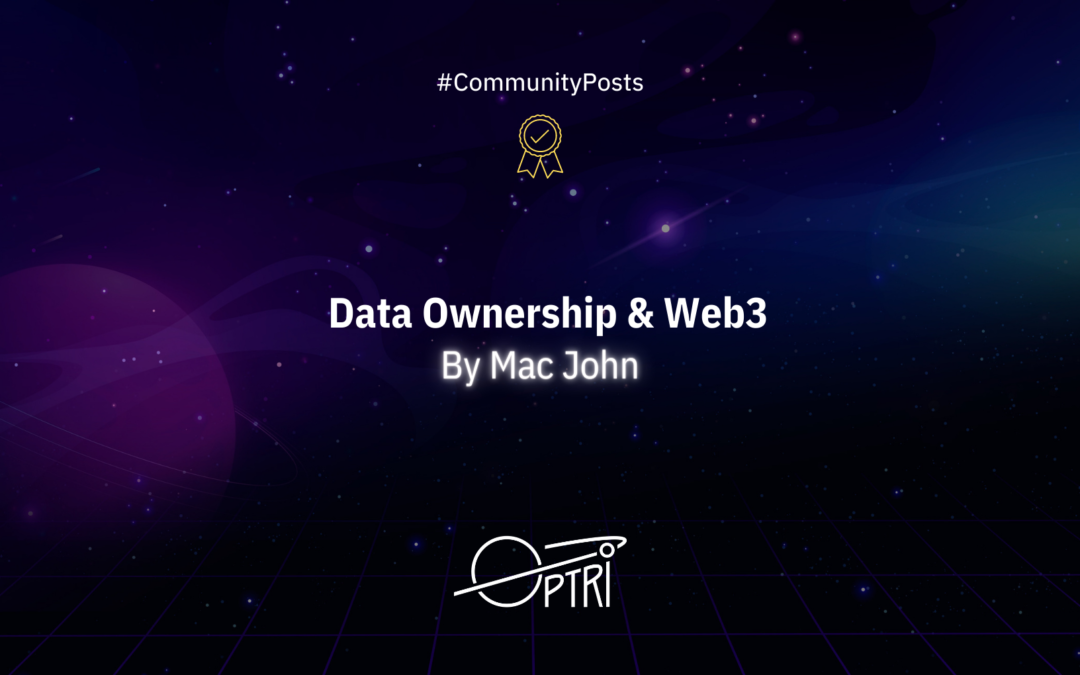We are gradually entering a revolutionary era of data ownership and Web3. A world with no centralized authorities, where everyone has control over their digital assets and also have the power to decide who can have access to this data.
The concept of data ownership have been trending in the recent years as many people become more aware of the value of personal data. Although, the ultimate use of Web3 is making sure this is become a reality. In fact, Web3 has given us another world for us where an individual can store, transfer and access their own data without having anything to do with decentralized institutions.
Therefore in this article, we are going to look at how Web3 is changing the concept of data ownership and what possibilities could this open up for us. I will also discuss the implications of this shift and how we can all get involved. Please, let’s dive in!
This post has been written by our community member from Discord. All content published without any modifications.
OptriSpace Team
What is Data Ownership?
In the simplest terms, this is the idea that people have the right to own and control their own data. In some cases, the company might own it.
Some examples of this data may include users personal information such as name, address, phone number and so on. May also include things like digital files, emails, words (phrase used in blockchain for security purposes), photos and other things that can be stored digitally.
Data ownership is a key factor in Web3 and it is something you need to know if you are going to be using the technology. In an ideal world, data ownership refers to your personal information stored digitally with safety and privacy put in place. Data owners have the full control over who can have access to their data, what they can do with it and as well as how long people can have access to it.
Data ownership also proved that the owners have the power to easily transfer their data without any loss of quality between platforms.
What is Web3?
In simple terms, it is a new standard for the internet that embraces decentralization, data ownership and to secure online transactions more easily.
Web3 uses the advanced cryptography to store data on a secure digital ledger which may be refers to as blockchain. As blockchain allows decentralized peer to peer communication to guarantee data privacy, security and reliability.
We can see that the implications of Web3 are huge which opens up new levels of users control over their own data, enabling the data owner to determine who can have access to their stored information and how this data can be used. This is possible because there’s no central organization controlling the data but instead all these data are distributed across multiple parties.
Also Web3 technologies like blockchain offer a higher level of security for protecting data from criminals looking for personal data for malicious purposes.
How Do Data Ownership and Web3 Interact?
Yes! Another important question here is how does data ownership fits into the larger picture of Web3 technology?
I’m sure we all know what blockchain is all about, in layman term, it’s a system that records and stores all data transactions.
And one of the biggest advantages of blockchain is that it allows every user to own the right to their data and to make decisions about who can have access to this data. Web3 technology also gives individuals the power to determine the bits of data they share with other third parties or companies without giving out their entire profile at all.
The combination of data ownership and Web3 can be seen to be so powerful as it shift the control away from large companies and bring it back into the hands of the individuals. This actually empowered citizens in the world when it comes to digital privacy nowadays.
Plus, in the Web3 technology, blockchain opens up lots of opportunities for developers that are looking for ways to create products or project for users who want to be interacting with smart contract, have access to decentralized applications generally known as dApps and many more.
What Benefits Does Data Ownership and Web3 Provide?
As data ownership and Web3 are promoting a new era of possibilities, so what benefits does data ownership and Web3 provide?
Some of these benefits can be pegged to transparency and control, as well as security and privacy. Allow me to rephrase this by saying;
- Transparency and Control
With data ownership and Web3, owners have the ability to control, access their data and also decide who can have access to the data. This ownership control over their own data actually put transparency into check as per who is actually using the data at that moment or at all times.
- Security and Privacy
Data ownership ensures that users’ privacy is protected when they are accessing their data. The end-to-end encryption and permission based access control, always prevent malicious attackers to have access to the data. This allows data to be safe from any potential threats or breaches as it travels across the Web3 networks.
Challenges Faced by Data Ownership and Web3
As data ownership and Web3 has opened up a new frontier of possibilities, but as with any new technology, there is going to be challengies. The main challenge here is related to scaling and how to manage the huge amount of data required for such applications.
Another important factor is trust. The trust users have in the platform and in the developers behind the project. There is also a need for mechanism that will ensure the security, consistency and integrity of data that is being exchanged in an open source environment. This actually where cryptography based techniques come into the picture to provide these assurances.
Plus, crytographic algorithms help protect data from curious eyes and criminals as we are sending data across networks, this offer a greater security compare to traditional methods. Cryptography also helps to maintain and verify the integrity of any transaction taking place over the networks and ensured that users’ data remain intact always without compromising the privacy or performance.
Interoperability among different blockchain based platforms and networks is another challenge that needs to be addressed. To ensure a safe and seamless transactions between different networks, interoperability needs to be built into protocols and applications for digital assets and every services based on Web3.
Finally, scalability issues related to high volume transactions due to population growth must also be addressed. This requires developing some kind of efficient consensus algorithms that can process multiple requests simultaneously with low latency and high throughput.
Conclusion
Data ownership and Web3 have revolutionize the way we conduct business and interact with online services while protecting our personal information by leveraging the blockchain and also building an architecture of trust and accountability. This make it possible for us to create an entirely new digital technology that allow users to have full control over their personal data.
I believe this is just the beginning. The possibility for utilizing this new technology is limitless and the only limit will be on how creative users can be in exploiting its power.
The future of data ownership and Web3 looks very exciting and believe me, it is only going to get better.
Author: Mac John
If you want to discuss this point of view – please join our Discord server or Telegram.

I’m a writer, cryptocurrency trader and Web3 researcher. A chemistry studies graduate of University of Ibadan, Nigeria. I am a cryptocurrency writer now, who love to research and keeps himself abreast of the latest crypto trends and patterns.

